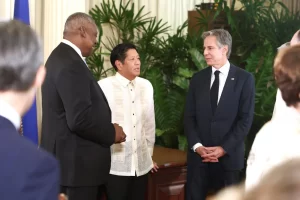President Marcos’s strategy for US-Philippines relations amidst China rivalry

Philippine President Ferdinand Marcos Jr. has underlined the significance of regular US-Philippine engagements to enable “agile” responses to maritime concerns with China. Marcos emphasized that these exchanges are vital for sustaining regional peace and stability amid the mounting security concerns in the South China Sea caused by the US-China rivalry.
Marcos additionally stressed that his administration’s foreign policy is primarily concerned with supporting the interests of the Philippines, rather than identifying with either the United States or China. This approach tries to reconcile the country’s strategic and economic goals while addressing the complicated geopolitical landscape in the region. Furthermore, the Philippines’ strengthening ties with the United States and Japan are viewed as a strategic measure to challenge China’s influence and assert the Philippines’ maritime claims. This three-way partnership is expected to increase security and freedom of navigation in the controversial waters of the South China Sea.
The 2024 Balikatan exercises, which are joint military training between the United States and the Philippines, were among the largest in history. These drills were expanded to 300 nautical miles into the West Philippine Sea, demonstrating a dramatic shift toward strengthening the Philippines’ defensive capabilities and projecting military might in difficult areas. The French navy took part in the exercises for the first time.
Marcos emphasized the necessity of the United States-Philippines cooperation for regional stability. During the Shangri-La Dialogue, he urged both the United States and China to manage their competition responsibly in order to preserve peace and stability. He emphasized that the Philippines’ decisions on the West Philippine Sea are taken independently and in its own national interest, without influence from the United States.
The United States stated its commitment to the 1951 Mutual Defense Treaty, providing support for the Philippines against armed attacks, particularly those on coast guard vessels. The increased U.S. military access to Philippine bases, particularly those strategically placed near Taiwan and the disputed Spratly Islands, highlights expanding military collaboration.
These activities are part of a larger strategic change in the region, with the US wanting to construct a network of land forces in the Pacific to discourage regional threats and back allies like the Philippines in preserving their territorial integrity and sovereignty.
